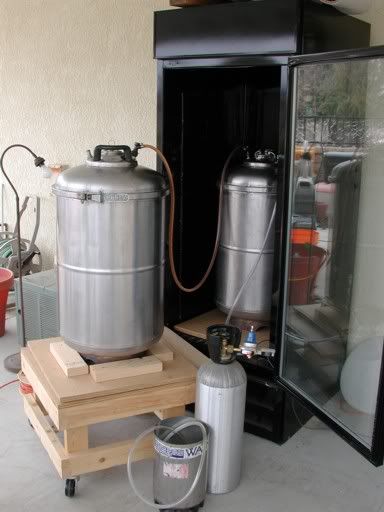coldrice
Well-Known Member
- Joined
- Oct 17, 2008
- Messages
- 188
- Reaction score
- 1
The equipment: 7cu ft. GE Chest Freezer (brand new), 2 stage Ranco Temp control, a small space heater, some duct tape, a white labs vial, some freezer pack goo and two thermometers (one digital and one dial).
So, yesterday (the first day), I set the temp control to 61F with a 2 degree diff on the freezer and a 3 degree diff. on the heater. I filled the White Labs vial with goo and duct taped it to the back wall of the chest freezer. Ran to work. I had my lady friend (kinda) monitoring things while I was at work. I got home and the display on the Ranco said it was 71F inside. Ouch. I opened it up and checked the thermometers and it was 52F. Ouch. Fermentation had stopped. Double Ouch. I took the probe out of the goo and dangled it in the center of the chest freezer and went to bed cuz I was spent. It cycled a lot, obviously cuz the fan is blowing right on it, but fermentation had restarted and it was 60F when i woke up. Then I tried the duct tape-the-probe-to-the-fermenter-with-a-piece-of-bubblewrap trick. No I didn't have the tape on the probe, it was on the bubble wrap. It still cycled too much I think cuz I don't have the right bubble wrap. Its been holding at 59F, which I'm not a fan of, so I set it at 63F with a 2 degree diff. on either side.
Now here's my new trick, I stuck the probe into the vial (got rid of the goo) and filled it on all sides with dryer lint. I would like to retain author's credit if this works and its the first time someone has tried it.
Here are the questions:
1 Should the probe be on the other side of the fermenter so the heater can't blow on it?
2 How do you fill the gaps in the rubber gasket where the cords from the heater and the probe come out of the freezer?
3 Am I stupid? Is it common to have this many problems?
4 Where are all the coils in the freezer? What are the hot zones/cold zones?
5 Should there be a blanket under the fermenter, perhaps?
Feel free to dissect my procedure and add any additional insights or anticdotes regarding my techniques/set-up
Thanks in advance
So, yesterday (the first day), I set the temp control to 61F with a 2 degree diff on the freezer and a 3 degree diff. on the heater. I filled the White Labs vial with goo and duct taped it to the back wall of the chest freezer. Ran to work. I had my lady friend (kinda) monitoring things while I was at work. I got home and the display on the Ranco said it was 71F inside. Ouch. I opened it up and checked the thermometers and it was 52F. Ouch. Fermentation had stopped. Double Ouch. I took the probe out of the goo and dangled it in the center of the chest freezer and went to bed cuz I was spent. It cycled a lot, obviously cuz the fan is blowing right on it, but fermentation had restarted and it was 60F when i woke up. Then I tried the duct tape-the-probe-to-the-fermenter-with-a-piece-of-bubblewrap trick. No I didn't have the tape on the probe, it was on the bubble wrap. It still cycled too much I think cuz I don't have the right bubble wrap. Its been holding at 59F, which I'm not a fan of, so I set it at 63F with a 2 degree diff. on either side.
Now here's my new trick, I stuck the probe into the vial (got rid of the goo) and filled it on all sides with dryer lint. I would like to retain author's credit if this works and its the first time someone has tried it.
Here are the questions:
1 Should the probe be on the other side of the fermenter so the heater can't blow on it?
2 How do you fill the gaps in the rubber gasket where the cords from the heater and the probe come out of the freezer?
3 Am I stupid? Is it common to have this many problems?
4 Where are all the coils in the freezer? What are the hot zones/cold zones?
5 Should there be a blanket under the fermenter, perhaps?
Feel free to dissect my procedure and add any additional insights or anticdotes regarding my techniques/set-up
Thanks in advance




